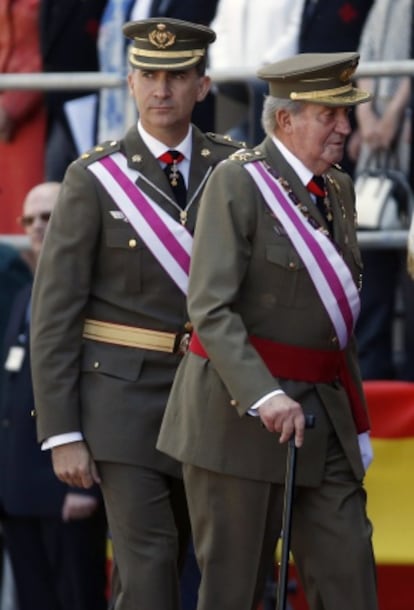An abdication plan that was five months in the making
King decided to renounce the throne the day before struggling with a speech at a January event


King Juan Carlos took the decision to abdicate on the day of his 76th birthday, January 5. It was the day before what would be one of his lowest moments as king, when, at the annual Pascua Militar armed forces ceremony in Madrid’s Royal Palace, he looked tired and nervous, finding it difficult to read his short three-page speech. It was not the image he wanted to convey, and from that moment on, he resumed his trips abroad and increased his activity so as to make sure the day that he announced his decision, nobody would think that he had been forced to quit, but rather that it was a decision he had taken.
The king first spoke about his plans with his son Prince Felipe and his wife Queen Sofía, and afterwards to the current head of the Royal Household, Rafael Spottorno, and his two predecessors in that role. He commissioned a report from them on the political, legal and practical aspects of his abdication, and once it was ready, he spoke to the government.
He told Prime Minister Mariano Rajoy of his plans on March 31. That was the day of the funeral of his friend Adolfo Suaréz, Spain’s first prime minister following the Franco dictatorship, and with whom the king paved the way for a successful transition to democracy. In his abdication speech on Monday, the king championed the legacy of that process, and “the exciting national task of allowing citizens to choose their legitimate representatives,” thus turning Spain into a “modern democracy.”
It was one of the few speeches of the many he has given that had not been written for him by the government
He told opposition Socialist Party leader Alfredo Pérez Rubalcaba, with whom he has always kept in contact, three days afterwards. And from then on he started working on his abdication with a small group of representatives from the Zarzuela royal palace and the government, including Deputy Prime Minister Soraya Sáenz de Santamaría. From January 5 onward, all efforts were focused on the plan, which included the Royal Household’s new Twitter account, a novel approach that pointed toward the dawn of a new era.
“He was convinced, resolute,” one of the few people with whom the king trusted his decision told EL PAÍS. “He told me it was the best thing for the crown and for Spain. He had no doubts.”
He told me it was the best thing for the crown and for Spain. He had no doubts”
He was determined, but it wasn’t easy. At 11am on Monday morning, half-an-hour after Spaniards found out that the king was to abdicate, he sat down in front of a camera to explain to why. But Juan Carlos was overcome with emotion, according to Zarzuela sources. The recording had to be interrupted several times as the king’s voice faltered as he read. The text was one of the few speeches of the very many he has given in his life that had not been written for him by the government. It was his most personal speech, his farewell speech: “Spain will always be in my heart,” he said. Prince Felipe, just back from a visit to El Salvador, was with him in the office that will soon be his. Felipe VI will, however, go on living in his current house, with Juan Carlos staying in the main Zarzuela Palace.
Juan Carlos, who wants to be remembered as “the king for all Spaniards,” spent Monday afternoon calling a number of officials, from Spain’s regional premiers and labor unions, to European Royal Households. “There’s never been as much interest around here like there is today, eh?!” he joked with the swarm of journalists tracking his every move on Monday. “Are you feeling sad?” he was asked by the press pack. “What do you all think? That question can only be answered with a question...”
Tu suscripción se está usando en otro dispositivo
¿Quieres añadir otro usuario a tu suscripción?
Si continúas leyendo en este dispositivo, no se podrá leer en el otro.
FlechaTu suscripción se está usando en otro dispositivo y solo puedes acceder a EL PAÍS desde un dispositivo a la vez.
Si quieres compartir tu cuenta, cambia tu suscripción a la modalidad Premium, así podrás añadir otro usuario. Cada uno accederá con su propia cuenta de email, lo que os permitirá personalizar vuestra experiencia en EL PAÍS.
¿Tienes una suscripción de empresa? Accede aquí para contratar más cuentas.
En el caso de no saber quién está usando tu cuenta, te recomendamos cambiar tu contraseña aquí.
Si decides continuar compartiendo tu cuenta, este mensaje se mostrará en tu dispositivo y en el de la otra persona que está usando tu cuenta de forma indefinida, afectando a tu experiencia de lectura. Puedes consultar aquí los términos y condiciones de la suscripción digital.
Últimas noticias
Most viewed
- Reinhard Genzel, Nobel laureate in physics: ‘One-minute videos will never give you the truth’
- Oona Chaplin: ‘I told James Cameron that I was living in a treehouse and starting a permaculture project with a friend’
- Pablo Escobar’s hippos: A serious environmental problem, 40 years on
- Chevy Chase, the beloved comedian who was a monster off camera: ‘Not everyone hated him, just the people who’ve worked with him’
- Why we lost the habit of sleeping in two segments and how that changed our sense of time








































